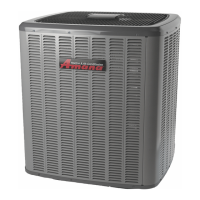SERVICING
38
Voltages between the two data lines and between each data line
and common may be used to determine if the network is operat-
ing properly.
Do the following to measure the voltages on the communications
data lines.
WARNING
Line Voltage now present.
1. With power on to the unit, measure voltage between terminal
"1" and terminal "C" on control board's thermostat connec-
tor. Voltage should be as noted in the table below.
2. Measure voltage between terminals "2" and "C".
3. Measure voltage between terminals "1" and "2".
4. If voltages are different than stated in the table below, check
thermostat wiring for opens/shorts. Confirm that the BIAS
and TERM dipswitches are in the ON position.
5. The network troubleshooting chart on the next page provides
additonal communications troubleshooting information.
Terminals
Nonimal dc
Voltages
1 to C > 2.5 Vdc
2 to C < 2.5 Vdc
1 to 2 > 0.2 Vdc
S-50 CHECKING HEATER LIMIT CONTROL(S)
(OPTIONAL ELECTRIC HEATERS)
Each individual heater element is protected with an automatic
rest limit control connected in series with each element to pre-
vent overheating of components in case of low airflow. This limit
control will open its circuit at approximately 150°F. to 160°F and
close at approximately 110°F.
WARNING
Disconnect ALL power before servicing.
1. Remove the wiring from the control terminals.
2. Using an ohmmeter test for continuity across the normally
closed contacts. No reading indicates the control is open -
replace if necessary. Make sure the limits are cool before
testing.
IF FOUND OPEN - REPLACE - DO NOT WIRE AROUND.
S-52 CHECKING HEATER ELEMENTS
Optional electric heaters may be added, in the quantities shown
in the spec sheet for each model unit, to provide electric resis-
tance heating. Under no condition shall more heaters than the
quantity shown be installed.
HIGH VOLTAGE!
Disconnect ALL power before servicing
or installing. Multiple power sources
may be present. Failure to do so may
cause property damage, personal injury
or death.
1. Disassemble and remove the heating element(s).
2. Visually inspect the heater assembly for any breaks in the
wire or broken insulators.
3. Using an ohmmeter, test the element for continuity - no read-
ing indicates the element is open. Replace as necessary.
S-60 ELECTRIC HEATER (OPTIONAL ITEM)
Optional electric heaters may be added, in the quantities shown
in the specifications section, to provide electric resistance heat-
ing. Under no condition shall more heaters than the quantity
shown be installed.
The low voltage circuit in the air handler is factory wired and
terminates at the location provided for the electric heater(s). A
minimum of field wiring is required to complete the installation.
Other components such as a Heating/Cooling Thermostat and
Outdoor Thermostats are available to complete the installation.
The system CFM can be determined by measuring the static pres-
sure external to the unit. The installation manual supplied with
the blower coil, or the blower performance table in the service
manual, shows the CFM for the static measured.
Alternately, the system CFM can be determined by operating the
electric heaters and indoor blower WITHOUT having the compres-
sor in operation. Measure the temperature rise as close to the
blower inlet and outlet as possible.
If other than a 240V power supply is used, refer to the BTUH CA-
PACITY CORRECTION FACTOR in the following chart.
BTUH CAPACITY CORRECTION FACTOR
SUPPLY VOLTAGE 250 230 220 208
MULTIPLICATION FACTOR 1.08 .92 .84 .75
EXAMPLE: Five (5) heaters provide 24.0 KW at the rated 240V. Our
actual measured voltage is 220V, and our measured temperature
rise is 42°F. Find the actual CFM:
Answer: 24.0KW, 42°F Rise, 240 V = 1800 CFM from the TEMPERA-
TURE RISE chart on the right.
Heating output at 220 V = 24.0KW x 3.413 x .84 = 68.8 MBH.
Actual CFM = 1800 x .84 Corr. Factor = 1400 CFM.
NOTE: The temperature rise table is for sea level installations.
The temperature rise at a particular KW and CFM will be greater
at high altitudes, while the external static pressure at a particular
CFM will be less.

